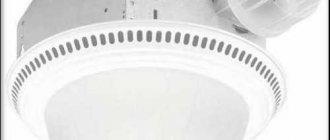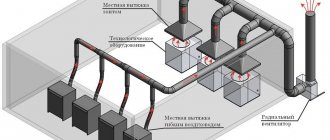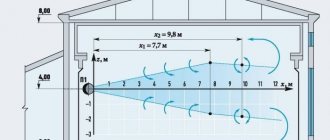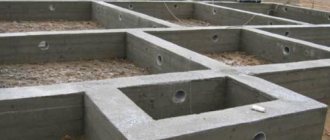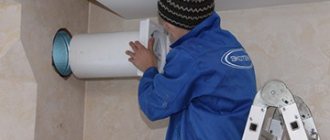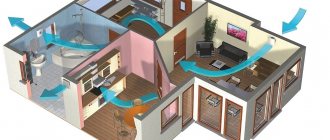Properly organized supply ventilation in an apartment is the basis for a comfortable microclimate in a living space. Very often natural air exchange does not provide sufficient fresh air and it is necessary to look for alternative ways to improve supply ventilation.
We will tell you everything about the existing options for organizing air exchange and help you choose the optimal method. The presented article describes in detail the simplest options for devices for improving ventilation and complex technical systems. Taking into account our recommendations, you will significantly improve your living conditions.
Why is a ventilation system needed?
indoor air humidity
Thanks to such systems, a comfortable microclimate is maintained inside the rooms. Several important problems are solved at once:
- Normalization of humidity levels.
If the air is too humid, it leaves the premises through the hood. Thanks to this, there are no areas of the room that always remain damp.
- Normalization of carbon dioxide levels.
Carbon dioxide is always present indoors, but its amount can and should be controlled. If you equip good ventilation systems , the composition of air flows will always be updated.
Some systems support additional functions, often including filtering. This is necessary to remove harmful substances. The heating function is relevant in the cold season.
Based on this characteristic, three main types of systems can be distinguished:
- Mixed.
- Mechanical.
- Natural.
Projects are developed in accordance with current standards and operating conditions of the owners. Ventilation of premises is now varied.
natural and mechanical ventilation
Natural
Natural ventilation still remains a popular and widespread solution for modern users. Air movement is associated with natural factors that have little influence on human influence. An example is due to the difference in pressure between the internal volume and the atmosphere outside.
The pressure inside the room should be slightly less than the same indicator for the street. Then the air begins to move through the installed channels.
An example is special channels that are installed within the walls of residential and apartment buildings. Affordable price becomes the main advantage of this choice. There is no need for a constant connection to electricity or the use of expensive equipment.
Movement is associated with a negative difference in pressure, but this rule does not always apply. Sometimes the indicators level out, which is associated with the termination of the system. Reverse thrust may also appear. Systems react too actively to environmental conditions.
An organized variety is planned in advance and installed according to certain rules.
Disorganization has become commonplace for old private houses, including those made of wood. Here the ventilation equipment is completely different.
Features of ventilation design
Considering what types of ventilation there are and their main parameters, it is possible to achieve the desired result. Buildings with poor ventilation systems risk dust accumulation. The use of household chemicals and the use of household appliances lead to changes in the physical and chemical characteristics of the air. Designing a residential building or industrial buildings is not complete without a pre-thought-out ventilation system.
Important! Calculations and conditions for ventilation systems are provided for by the relevant building codes and laws.
A properly planned system allows you to achieve the necessary microclimate indicators. Various types of ventilation of premises - residential, public, industrial - have their own standards and requirements. All this is an important engineering and technological aspect. Only competent design of ventilation systems will ensure consistently acceptable conditions in any buildings.
Supply
principle of operation of supply ventilation
It is necessary for air to flow from the street into the room. It can be represented by such components that perform their functions.
- Ventilator.
Mounted on the wall inside the apartment. Supplies fresh air inside using special fans.
- Supply valve.
A wall or window valve is necessary when it is necessary to increase the inflow that already exists. Ventilation of this type is characterized by low prices. The main thing is to remember that the supply valves are quite dependent on the prevailing weather conditions. The more heat there is outside the window, the smaller the pressure difference will be. In summer, such ventilation will not be very effective.
- Breezer.
Air purifier and ventilator at the same time. It not only supplies air, but filters it, heating the contents if necessary. Allows additional control of the system from a smartphone. The filter is built in if necessary.
Channel cleaning
About the need to clean the ventilation
Proceed with an individual check of each vent. If the paper behaves differently, contaminants are present in the inner boxes.
To eliminate such a nuisance, it is enough to arm yourself with an ordinary dish brush attached to a flexible and thin steel cable, and walk a similar structure along the ventilation duct.
Cleaning the ventilation in the apartment
You can get rid of residual debris using a vacuum cleaner with a long tube. For example, you can connect a long piece of an ordinary flexible hose for irrigation. Such a product has the required flexibility and is, at the same time, quite rigid.
If, as a result of the measures described above, you do not find any blockages, then the problem is at the level of the main ventilation duct. Its cleaning is carried out in the order already familiar to you, you just need to take a larger brush. Additionally, you may need other devices, for example, a fiberglass rod, a metal or wooden rod, a hook, etc.
Ventilation cleaning
Use extreme caution when cleaning the main vent. Wasps and other dangerous or extremely unpleasant living creatures often build their nests in them.
Cleaning ventilation from fatty deposits
Please also take into account the fact that in most cases, residents of apartment buildings are prohibited from climbing into the main ventilation duct on their own - caring for it is the responsibility of the organization on whose balance sheet the building is located, or the homeowner. Therefore, it is better to immediately submit an application to the appropriate place in order to avoid further unpleasant proceedings and not to do unnecessary work that is not part of your responsibilities.
Local
It works to provide clean air to specific places indoors. Polluted streams are also removed from specific areas where they are formed. A current option for large premises where a limited number of workers can be accommodated. Air exchange is organized only for places where the main activities for the performance of duties are carried out. Air heater – additional equipment.
Here, ducted or ductless arrangement options are distinguished.
Ductless
ductless ventilation
In this case, an almost complete absence of ducts is assumed. An example of such systems is ordinary fans. They can be ceiling-mounted or laid under the ceiling. They consume less energy and differ from analogues in affordable prices.
It solves not only the main tasks, but also some others that are assigned to the system. If necessary, turns on the recuperator and silencer.
What kind of ventilation is there?
Ventilation is a set of devices and measures to ensure normal air exchange in a building. Based on this concept, the classification of ventilation is divided as follows:
- according to the method of air movement and pressure - artificial and natural ventilation;
- by use - exhaust and supply ventilation;
- by service area - general and local;
- By design - ductless and duct ventilation.
By considering each type in order, you can determine the main advantages and disadvantages of ventilation systems. In order to maintain the necessary microclimate, it is necessary to carefully study the issue of classifying ventilation units and apply them in accordance with the necessary parameters. The types of ventilation in residential buildings are not very different from those installed in industrial and public buildings.
With filtration
Includes air filters that differ from each other in design and purpose. Example:
- Simple varieties with a mesh structure.
- A complex plexus of fine fibers inside.
- Carbon filters that trap dirt along with unpleasant odors. The air ducts are also modern.
Currently, there are quite strict requirements for the regulatory composition of air used indoors. For city apartments, the ventilation system is a device that does not involve intervention. Private developers do not work with such strict regulations; they rely on the capabilities and needs of each specific customer. The design allows the use of various materials and parts, even air distributors are different.
Plastic air ducts often play the function of a shaft. Unified connections make it less of a hassle to assemble systems yourself. The main thing is to ensure that the following problems are resolved:
- Correct selection of components.
- Mutual compatibility.
- Sufficient performance.
Metal elements are superior in reliability, but during installation they cause much more trouble. The installation of pipes and ducts made of galvanized steel requires additional skills from the master. Textiles and aluminum are also found on the modern market, although less often than other solutions. The recovery system and coolers are selected individually.
Conclusions and useful video on the topic
This video is a kind of educational program about ventilation. Here the very concept of ventilation is discussed in detail and all issues related to its competent design are covered:
Master class on installing a ventilation system:
Both business managers and private developers must understand that the normal functioning of those for whom they are responsible depends on the effectiveness of ventilation. Sometimes people's lives are also in question. You cannot miss this moment and save on it.
Have questions about the topic of the article, found any shortcomings, or have valuable information that you could share with our readers? Please leave comments, share your experience, and participate in discussions.
About lattices
ventilation grilles
A device that performs an air distribution function. A variety of technological holes that lead to the main shaft. A house may include 1-10 bars, in some cases there are more. There are supply and exhaust depending on the functions performed at the present time. There are several installation options:
- Independent designs.
- On the floor.
- On the walls.
- In the ceiling.
There are different grating options from modern manufacturers. These are slotted and perforated, mesh products. They are complemented by devices for adjusting air flows and shutting off. Automated systems have motors, sensors, and controllers. The main thing is that the system together with its components does not cover the diameter of the air ducts by more than 40%. The air humidifier should also not create obstacles.
Budget options for restoring air exchange
Wall and window valves do not have a fan. The air flow occurs due to the difference between street and “home” pressure. A prerequisite for the operation of overhead inlets is proper exhaust ventilation.
Features of different types of window valves
The design of all window climate control devices is very simple. A typical valve consists of an air intake, a telescopic duct and an indoor unit.
The air intake is installed outside the frame. The external unit is equipped with a visor and a grille that prevents insects from getting inside. The telescopic channel cuts into the frame, forming a through gap for the unhindered flow of air.
The indoor unit is mounted on the side of the room. Some models of inlet units are equipped with a filter and a valve that regulates the throughput of the device
Based on the design features and installation method, the following climate control devices are distinguished:
- slotted;
- folded;
- invoices.
Slot models. The throughput capacity of the unit reaches 20 cubic meters per hour - the influx of air masses is carried out through a micro-hole up to 1.6 cm high and up to 4 cm wide. The device consists of two blocks, which complicates its installation - milling of the window frame is required .
Rebated valves. This is the most affordable and easiest way to ventilate a room. The air flow is carried out through slits in the vestibule. The main advantage of the models is the ability to install them on a window in use without milling a groove.
Additional advantages of rebated models include: low cost, preservation of the sound-absorbing and heat-retaining properties of PVC double-glazed windows and the possibility of automation.
The valve capacity does not exceed 5 cubic meters/hour. To ensure a larger volume of air supply, it is permissible to install several valves on one window
Overhead climate products. This option is rarely implemented in domestic conditions due to the complexity of installation - the valve is inserted at the stage of assembling the double-glazed window. In addition, the product worsens the heat and sound insulation of the window.
Overhead modifications have found their application in production and warehouse premises. The productivity of climate control devices is about 100 cubic meters per hour.
In the simplest models of window inlets, the size of the gap, and, consequently, the intensity of the air flow, is selected manually - the position of the valve is adjusted. High-tech devices are equipped with humidity and atmospheric fluctuations sensors.
Wall model: device and installation
Externally, the wall valve resembles a cylindrical flask or a wide pipe, with a diameter of about 10-16 cm.
The plastic air duct is equipped with the following elements:
- thermal insulation layer - a “sleeve” passes through the entire flask, preventing freezing of the wall and reducing the noise effect from the street;
- filter – located at the outlet of the air duct, provides rough air cleaning.
In some models, an O-ring (silicone) with flaps is placed in front of the filter. The purpose of the part is to equalize the air flow in windy weather.
On the street side, the wall air duct is closed with a metal grille and an anti-mosquito insert, and on the inside - with a decorative cover with an adjustable handle
When choosing an air supply device, the power and “operating” temperature of the unit are first assessed. On average, the productivity of a wall climate product is 40 cubic meters/hour. This value is enough to ventilate a room of 13 sq.m.
The operating temperature range is indicated by the manufacturer on the packaging or in the instructions for the device. For harsh climatic conditions, special models have been developed to prevent the formation of condensation and the appearance of an ice plug in the channel.
The following photo selection will clearly introduce the technology of installing a wall valve:
Image galleryPhoto from At a height of approximately 2 - 2.2 m from the floor plane, we drill a hole in the wall. We select the drill bit in accordance with the size of the future ventilation duct. We rework the hole with a drill of a smaller diameter, trying to give it a slight slope towards the street. In the hole drilled and cleared of dust, we first install insulation, made in the form of a pipe, then a plastic air duct. We cut the insulation flush with the surface, the air duct should protrude by 1 cm. We apply the lower part of the housing to the installation site and mark the fixation points of the device through the holes in it. We fix the lower part of the housing to the wall by drilling holes at the marked points. We place the included filter in the housing. We snap onto the upper part of the housing, equipped with a device for adjusting the air flow. We check the functionality of the system and the ability to regulate the volume of air flow entering the room. On the outside of the wall, we install a grille with inclined lamellas, it will protect against insects and birds. Step 1: Drilling holes for installing the valveStep 2: Refinishing the hole with a drillStep 3: Arranging the drilled holeStep 4: Marking for attaching the valve bodyStep 5: Installing the filter into the fixed bodyStep 7: Installing the supply valve coverStep 7: Checking the functionality of the systemStep 8: Installing the grille from the facade
Stage 1. Determining the location. When choosing a wall, you should consider some nuances:
- It is better to install it on a supporting structure;
- optimally – the valve “exit” to the insulated loggia;
- It is better to avoid installation from the side of the roadway.
Valve manufacturers have designated recommended and undesirable areas for installing the device. When installing, it is important to consider the air flow vector.
In the first option, fresh air entering the apartment warms up at the top and falls down. The second option is that the air masses are heated by the heating radiator
Stage 2. Preparation and drilling of the wall. On the inner wall, mark the place for the through hole and draw the diameter of the valve.
Channel drilling procedure:
- Perform initial drilling with a diamond core bit to a depth of 10 cm.
- Remove debris and use a chisel to knock out a small notch for stable placement of the drill.
- When drilling, keep the slope outward - this position of the air duct will prevent rainwater from getting inside the device.
It is better to carry out the work with an assistant who will periodically wet the drilling area. Humidification will reduce dust levels and protect the instrument from overheating.
Stage 3. Installation of valve components. Clean the groove from dust and place a heat-insulating “sleeve” in the channel. Using screwing movements, install the cylindrical body of the device, and secure the fine-mesh grid on it.
A panel, a ring with dampers and a filter are fixed from inside the wall. The final stage of assembly is installation of the lid with the adjusting handle
Diffusers
They also perform distribution functions, essentially the evolution of lattices. But the devices are more technologically advanced and modern. To smoothly change the amount and direction of air masses, they are equipped with additional sensors and regulators.
More often the term is associated with the arrangement of forced ventilation systems. Their main difference is the smaller diameter of the technological holes. Designers use the element when designing modern interiors, as their appearance is reminiscent of lighting fixtures. A dehumidifier is another type of add-on.
Fans
Ventilation system fans
According to the principle of operation, they can be axial or radial. The models also differ from each other in terms of functionality. Axial mechanisms are the traditional configuration. An impeller is fixed on the engine shaft, air is captured by the blades. Then the flows move in the right directions. Reverse connection is another difference from radial varieties. That is, air flows can be directed in all directions at once. With small pressure differences inside, the permeability remains high.
In the case of radial designs, the air accelerates between the inlet and outlet pipes. The impossibility of reverse movement is characteristic. Serious pressure can be created at the inlet and outlet, which also acts as one of the main differences.
Components of ventilation
As already noted, any ventilation that brings fresh air flow into the room is divided into types depending on the following characteristics:
- by appointment;
- service locations;
- the way the air flow moves;
- design features.
Regardless of the type of system used, almost all of them use a standard set of components:
- fans and ventilation units and units - devices that provide air movement in any direction;
- thermal curtains are used to prevent the passage of the air mixture into a certain area or change its direction;
- noise absorbers - for quiet operation of equipment;
- filters and air flow heaters - devices designed for cleaning and necessary air treatment;
- air ducts through which air flows move;
- regulating and locking devices that serve to control the operation of the entire system;
- air flow distributors that control its movement.
Thus, there are many types of air purification systems, thanks to which you can provide high-quality ventilation for any occasion and type of room.
Calorifiers-heaters
When air is taken in, it organizes a preliminary increase in the flow temperature. The option is effective in any use scenario. With a closed circuit, the heating efficiency remains as high as possible. Once inside the home, the characteristics do not change significantly. The automation system is often supplemented with not one heater, but several at once.
It is not always worthwhile to equip the system with all the solutions that exist on the market at once. The choice is determined by the needs of the customer and the capabilities of the specialist responsible for solving the problem. Preliminary accurate calculations help to avoid overpayments. This will make it easier to decide which functions are most important for a particular house or apartment. It is important to pay attention not only to personal comfort, but also to maintaining a healthy environment in general. Fresh air strengthens the immune system and eliminates a large number of negative effects. The correct organization of the systems themselves is also important.
Installation stages
The use of this type of ventilation is relevant in any room - from the bedroom to the kitchen. The number of valves can be selected in this way:
- 1 valve under each window.
- 1 valve for every 15-20 “squares” of area.
To install the ventilation valve you will need the following set of tools:
- Pencil (marker, pen).
- Hammer.
- Crown for concrete (diameter – 60 mm).
- Drill for concrete (diameter – 40 mm).
- Drill for concrete (diameter – 6 mm).
- Industrial vacuum cleaner (if not, use a broom and dustpan).
- Polyethylene (or rags) - to cover the work area.
- Thick and durable plastic garbage bag.
The product is installed above the battery so that the outlet “looks” at its center. In this case, the distance from the case (or rather, from the outlet) to the radiator must be at least 15 cm.
Drilling a hole for the air duct of the Domvent valve
Now let's look at the process step by step:
- Marking is carried out: the housing is applied to the wall in the selected location.
- Mark the center of the hole for the pipe and the holes for the fasteners.
- Using a crown with a diameter of 60 mm, the wall is drilled to a depth of 7-10 cm. In order not to litter the floor in the room, you should place a bag under the hole (or lay down film/rags).
- Using a drill with a diameter of 40 mm, the wall is drilled through.
- A plastic tube is inserted into the hole made. From the outside it should be flush with the surface of the wall, from the inside it should protrude by 7-10 mm. If necessary, the pipe should be cut to the required size.
- A heat insulator is placed on the end of the tube closest to the room. It should protrude from the hole by about 10 mm, no more. If necessary, excess is cut off.
- From the outside (from the street) a grate is glued to the tube (this will have to be done while leaning out of the window).
- Using a drill with a diameter of 6 mm, holes for fasteners are drilled.
- Fastener plugs are inserted into the holes.
- The valve body is pressed against the wall and fixed with self-tapping screws.
- An anti-mosquito net and seals are installed in the housing.
- The housing closes.
The procedure itself, with the participation of two people and the presence of the above-mentioned tool, will take about an hour on average. The cost of installing a Domvent ventilation valve by hired specialists will cost approximately 2,000 rubles.
Installation stages (video)
Care and cleaning
Over time, the use of the product leads to the fact that the seal located inside the housing gradually becomes dirty. It is recommended to clean it approximately once a year. The warm season is best suited for this, since the use of a ventilation valve is primarily relevant in cold weather.
To clean the sound absorber of the Domvent ventilation valve, you need to remove the housing cover, take out the seal and simply shake it several times to get rid of dust. Alternatively, you can do this with a vacuum cleaner (which is much more effective).
If there is too much dirt, you can wash it with a polyf under low-flowing water. In this case, the seal must be dried before installation. After cleaning, the sound absorber is installed back and covered with the housing cover.
Disassembled Domvent valve body
In addition to getting rid of dust, in winter you should pay attention to the condition of the outer grille - in severe frosts it can freeze. To solve the problem, the valve damper must be completely closed until the ice has completely melted.
Reviews about the model
It’s easy to find reviews about this model - many people have already installed it in private houses, apartments, and non-residential premises (offices, workshops, and so on).
Alexey V., 30 years old, Omsk:
About 3 years ago, supply valves were installed in our office so that noise (we are located in an area with constant construction) would not distract people from work. In winter, of course, you have to close it - despite the fact that the valve is located near the battery - the air still comes in cold.
But in the summer it is an irreplaceable thing. There is no need to open the windows, and the air conditioner is also turned on less often.
Dmitry A., 41 years old, Krasnodar:
In our country now, probably, all new buildings are immediately equipped with inlets. Last year we were choosing an apartment, probably looking at 15 options - and almost every new building had valves. The one we chose in the end turned out to be a Domvent: one in each room.
The model is not bad for its price - it has inflow adjustment and insulation (although it is more likely for show - such insulation is of little use, especially in colder latitudes). Well, it doesn’t let in much air - one valve is definitely not enough for the room.

